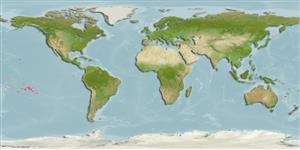Classification / Names
Common names | Synonyms | Catalog of Fishes (gen., sp.) | ITIS | CoL | WoRMS | Cloffa
Actinopterygii (ray-finned fishes) >
Perciformes (Perch-likes) >
Apogonidae (Cardinalfishes) > Apogoninae
Etymology: leisi: 10656.
Environment / Climate / Range
Ecology
Marine; reef-associated; depth range 0 - 18 m (Ref. 93673). Tropical, preferred ?
Central Pacific: known only from French Polynesia.
Size / Weight / Age
Maturity: Lm ? range ? - ? cm
Max length : 3.8 cm SL male/unsexed; (Ref. 93673)
Short description
Morphology | Morphometrics
Dorsal
spines
(total): 9;
Dorsal
soft rays
(total): 9;
Anal
spines: 2;
Anal
soft rays: 8;
Vertebrae: 24. This species is distinguished by the following characters: usually 6-9 pored lateral-line scales and 14-16 gill rakers and rudiments; body scale margins are uniform to narrow dark edged; body mottled brown with 2-3 faint dark bars, the first below posterior part of first dorsal fin, the second below mid-second dorsal fin, and the third on anterior caudal peduncle; axil of pectoral fin without spot; 3 whitish basicaudal spots; no white spot behind posterior base of soft dorsal fin; second dorsal fin, anal fin and caudal fin pale with faint reddish banding (Ref. 93673).
Occurs in lagoons, bays and near mouths of small tidal streams; one specimen was collected in a pen shell, Atrina pectinta. Specimens were collected with rotenone without identifying cryptic associations/locations during the day (Ref. 93673).
Life cycle and mating behavior
Maturity | Reproduction | Spawning | Eggs | Fecundity | Larvae
Fraser, T.H. and J.E. Randall, 2011. Two new species of Foa (Apogonidae) from the Pacific Plate, with redescriptions of Foa brachygramma and Foa fo. Zootaxa, 2988:1-27. (Ref. 93673)
IUCN Red List Status (Ref. 115185)
CITES (Ref. 94142)
Not Evaluated
Threat to humans
Harmless
Human uses
More information
Common namesSynonymsMetabolismPredatorsEcotoxicologyReproductionMaturitySpawningFecundityEggsEgg development
Age/SizeGrowthLength-weightLength-lengthLength-frequenciesMorphometricsMorphologyLarvaeLarval dynamicsRecruitmentAbundance
ReferencesAquacultureAquaculture profileStrainsGeneticsAllele frequenciesHeritabilityDiseasesProcessingMass conversion
Tools
Special reports
Download XML
Internet sources
Estimates of some properties based on models
Phylogenetic diversity index (Ref.
82805): PD
50 = 0.5078 [Uniqueness, from 0.5 = low to 2.0 = high].
Bayesian length-weight: a=0.01549 (0.00726 - 0.03306), b=3.06 (2.88 - 3.24), in cm Total Length, based on LWR estimates for this (Sub)family-body shape (Ref.
93245).
Trophic Level (Ref.
69278): 3.3 ±0.5 se; Based on size and trophs of closest relatives
Resilience (Ref.
69278): High, minimum population doubling time less than 15 months (Preliminary K or Fecundity.).
Vulnerability (Ref.
59153): Low vulnerability (10 of 100) .
